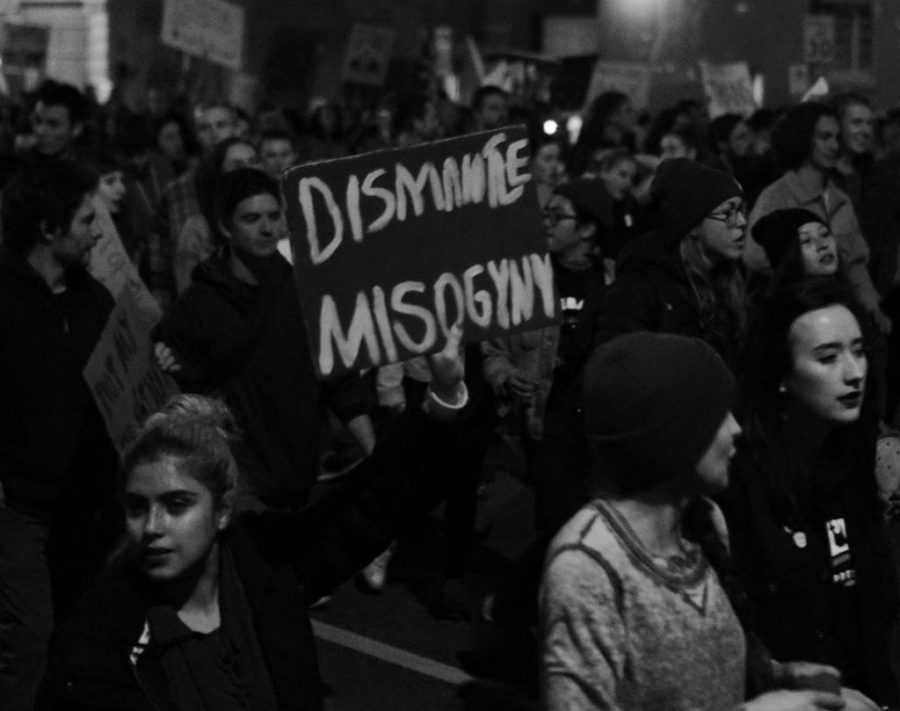Lien: The Changing Face of Sexism
A woman holds a Dismantle Misogyny sign while marching in downtown during the “Say No to Trump’s Agenda” rally and protest in Salt Lake City, Utah on Thursday, Nov. 10, 2016. (Rishi Deka, Daily Utah Chronicle)
March 22, 2023
The presentation of sexism and misogyny has changed over time. Women and femme-aligned people now have protections in place, such as Title IX, that prohibit discrimination on the basis of gender. These measures, unfortunately, have not eradicated sexism. The practice of sexism has simply adapted to the times. While now women can own property, form binding contracts and divorce their husbands, women today still need their husbands’ signatures to get their tubes tied.
Subtle misogyny still adversely affects its targets, even if it’s not always obvious.
For the purposes of this argument, I’ll primarily refer to “women.” I use this as a blanket term for cis-women, transwomen and those who exhibit feminine characteristics but don’t use female-coded language for themselves.
Sexism from people is categorized into three different types. In comparison to hostile sexism, which includes using sexist language, making threats or assaulting an individual, benevolent sexism is more socially acceptable and endorsed by both men and women. Benevolent sexism views women as innocent, pure or in need of protection — but it’s not a good thing. A 2020 study found that men who support benevolent sexism were more likely to support policies limiting freedoms for pregnant women. It also undermines women and girls’ confidence in themselves and their abilities by framing them as needing protection from someone stronger.
Hostile sexism doesn’t go unnoticed, but often goes unchecked. This makes it even more difficult for those experiencing more nuanced forms of oppression. One good and still relevant example of this is the gender pay gap. Examples of subtle misogyny include women consistently getting cut off when they speak, getting confined to administrative work or workplace cultures excluding female executives. Benevolent sexism reinforces established gender norms and stereotypes about male and female behaviors. Hostile sexism punishes those who challenge these roles, while benevolent sexism celebrates those who conform.
This may seem like a needless issue. After all, women have the right to vote already, what more rights do we need? I’m allowed to go outside by myself, speak for myself, handle my own money and make decisions regarding my personal relationships. However, having the ability to do these things does not mean that sexism doesn’t exist or affect us. The internalization of sexist rhetoric leaves women and girls in a bad spot. Not only is there a lower rate of women in STEM, but sexist stereotypes can affect academic performance.
Barriers to education are visible even at the University of Utah. While women actually make up 60% of undergraduates in higher education, outnumbering men at 40%, the U is below average. As of 2022, 52.5% of our undergraduates were men, compared to 47.5% women.
Sexism even has physical detriments. According to a 2018 study, women are more likely to report poor physical health, and a review from the same year found that doctors were more likely to view women’s chronic pain as exaggerated or imagined.
There’s no one quick fix for misogynistic behaviors. They’re exacerbated by the systems we live in, and change takes time. I also wouldn’t recommend making oneself a martyr. A number of articles on how to fight subtle sexism in the workplace all conclude with the general solution of calling out the problematic behavior. This is important, but not always reasonable or even possible. Sometimes, making waves means the beginning of the end in a job.
When it comes to employment discrimination and an individual has the means, taking the offender to court can help in righting the injustice. When this isn’t feasible, file complaints with human resources or the Equal Employment Opportunity Commission.
If you’re dealing with sexism socially, things aren’t so cut-and-dry. Challenge misogynistic beliefs. Ask why a sexist joke is funny. Create space for both the change and reconciliation of toxic behaviors. Keep in mind that no one is obligated to call out sexism when it’s witnessed — it takes emotional energy and sometimes can create a dangerous environment. It’s not always possible to avoid or stop sexist behavior and if it starts to take a toll on your physical and mental wellbeing, it might be time to reach out to a therapist. Some focus specifically on gender-based discrimination, but any therapist should help build assertiveness skills, work through internalized sexism and bolster your self-esteem.
Misogyny and sexism still exist and work against women. While it’s easy to note how much better things are now, social conditions can and should always improve. We need to recognize problematic behavior and call it out when we can. Tolerating it helps no one.









Susan M • Mar 25, 2023 at 11:10 am
Another type of sexism that still exists is implicit bias. Studies find that people assume men are better at performing tasks, like playing a musical instrument, but when musicians are put behind a screen and listeners can’t tell if it’s a man or woman playing, they are rated equally as good.
Parents behave the same way, assuming their daughters can’t perform as well, so their encouragement is diminished, and their daughter’s experience and confidence becomes limited.
Women exist in a world where the default is “you are not as good.” So they must work twice as hard and make half as many mistakes to prove they are equally as good. That is not a society free of sexism. That is an unjust society.
bjorn • Mar 25, 2023 at 10:52 am
Great read. Thank you.